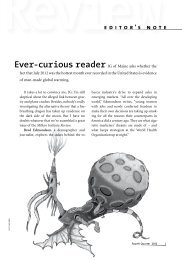The Rise and Fall of the U.S. Mortgage and Credit ... - Milken Institute
The Rise and Fall of the U.S. Mortgage and Credit ... - Milken Institute
The Rise and Fall of the U.S. Mortgage and Credit ... - Milken Institute
You also want an ePaper? Increase the reach of your titles
YUMPU automatically turns print PDFs into web optimized ePapers that Google loves.
Overview <strong>of</strong> <strong>the</strong> Housing <strong>and</strong><br />
<strong>Mortgage</strong> Markets<br />
<strong>The</strong> mortgage market has witnessed several trends in recent years:<br />
• Total loan originations (new loans issued) increased from $500 billion in 1990 to $2.4 trillion in 2007 before<br />
declining to $900 billion in <strong>the</strong> first half <strong>of</strong> 2008. Total amount outst<strong>and</strong>ing increased from $2.6 trillion to<br />
$11.3 trillion over <strong>the</strong> same period.<br />
• <strong>The</strong> FHA <strong>and</strong> VA share <strong>of</strong> mortgage originations declined sharply, from 16 percent in 1990 to less than<br />
4 percent in 2007, as <strong>the</strong> private sector become increasingly important for home mortgage funding.<br />
This trend was reversed after 2007 in <strong>the</strong> wake <strong>of</strong> <strong>the</strong> mortgage market meltdown.<br />
• From 1990 to 2008, adjustable rate mortgage originations tripled, before declining to $106.7 billion in <strong>the</strong><br />
first half <strong>of</strong> 2008. <strong>The</strong> outst<strong>and</strong>ing amount grew tenfold.<br />
• <strong>Mortgage</strong> originations to less creditworthy borrowers (in <strong>the</strong> form <strong>of</strong> subprime <strong>and</strong> Alt-A loans) displayed<br />
sharp increases during <strong>the</strong> boom, followed by big drops in <strong>the</strong>ir shares after <strong>the</strong> bubble burst.<br />
Prior to 1980, <strong>the</strong> vast majority <strong>of</strong> all home mortgage loans were made by savings <strong>and</strong> loans, which originated,<br />
serviced, <strong>and</strong> held <strong>the</strong> loans in <strong>the</strong>ir portfolios, in what is widely referred to as an originate-to-hold model. But over<br />
time, home mortgages were increasingly securitized (i.e., put into pools <strong>and</strong> packaged into securities backed by <strong>the</strong><br />
individual loans) <strong>and</strong> sold in <strong>the</strong> secondary market; this process is <strong>the</strong> originate-to-distribute model.<br />
Securitization, which allowed <strong>the</strong> mortgage market to tap into a broader base for funding, also “unbundled”<br />
<strong>the</strong> three sources <strong>of</strong> revenue derived from home mortgages. Some firms (mortgage brokers) could h<strong>and</strong>le <strong>the</strong><br />
origination function, o<strong>the</strong>r firms could opt to service <strong>the</strong> mortgages, <strong>and</strong> investors could receive <strong>the</strong> interest <strong>and</strong><br />
principal payments on <strong>the</strong> loans. This business model eventually had major ramifications, opening <strong>the</strong> door to an<br />
acceptance <strong>of</strong> riskier loans by originators, who could shift that risk to o<strong>the</strong>rs.<br />
During <strong>the</strong> housing boom, some<br />
borrowers used <strong>the</strong>ir home equity to<br />
juggle debt or finance lifestyles <strong>the</strong>y<br />
could not truly afford.<br />
5















